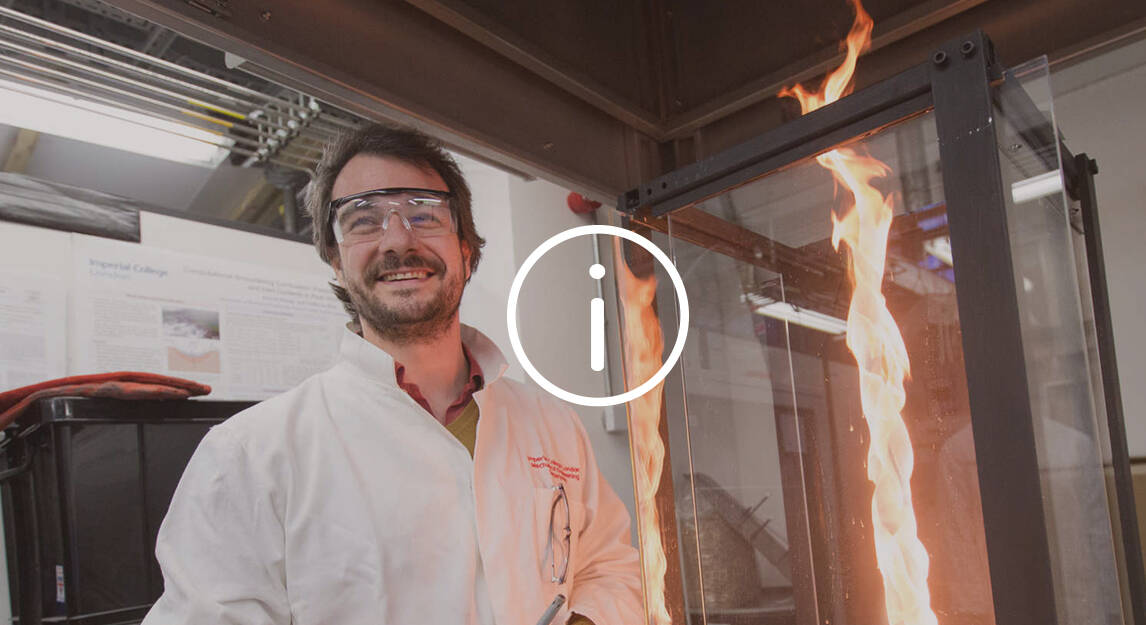
19 Jun Meet the Experts: Professor Guillermo Rein
For this edition of Meet the Experts we spoke with a renowned figure in the field of Fire Science. We talked with Guillermo Rein, professor of Fire Science at the Department of Mechanical Engineering of Imperial College London.
His ample research and projects focus on fire, heat transfer and combustion. The main purpose of his work is to reduce the worldwide burden of accidental fires and protect people, their property, and the environment. He especially enjoys solving multidisciplinary problems combining experimental and modelling techniques.
Make sure to read our interview below if you would you like to know more about professor Rein’s expertise and his view on the role and the future of fire safety.

© Image by Joe McGory via Imperial College London.
Authority in the field
Guillermo Rein gained his years of experience through extensive practice and education: he studied Mechanical Engineering at ICAI Universidad Pontificia Comillas (Ingeniero Industrial, 1999) and also holds an MSc (2003) and PhD (2005) from the University of California at Berkeley.
He has studied a wide range of fire dynamics topics in the built and the natural environments, including pyrolysis, smouldering, fire modeling, wildfires, structures and fire, design methodologies and forecasting techniques.
Rein is also Editor-in-Chief of the journal Fire Technology and he leads the research group Imperial Hazelab. Moreover, he is an extremely motivated teacher, enthusiastic about the education of the next generation of engineers, and passionate about outreach in engineering.
His work is well-known and has been recognised internationally with various research awards including: 2018 SFPE Guise Medal, 2017 The Engineer Collaborate-to-Innovate Prize, 2017 Combustion Institute Sugden Award, 2016 SFPE Lund Award.
Conversation with a specialist
Guillermo, as a Professor of Fire Science at the Department of Mechanical Engineering of Imperial College London, could you tell us what moved you to study and work on this area and what exactly is fire science?
I’m a mechanical engineer, both in my bachelor’s degree and my master degree and my PhD. And when I was finishing my PhD I was working at the University of California in Berkeley helping to understand how polymers burn in space, how plastics burn in space, inside a spacecraft, because there is no gravity.
And when I graduated I thought that was an absolutely fascinating topic: to protect the lives of people and to go to space, to go to Mars. And then I wanted to have an academic career on Earth. So I have my background in mechanical engineering and heat transfer and combustion and chemistry. And I use all that to understand fires on earth, in buildings and forests, so I can protect and help citizens, properties and the environment.
Fire science is the scientific branch to discover knowledge on how fires behave, how they ignite, how they spread, how they emit smoke and how they can be suppressed. This scientific knowledge is then given to engineers and authorities, who can then use that knowledge to create new technologies, combine it with previous things that they know work or to create new things. And little by little, by combining knowledge and engineering we can create a safer world.
Prof. Isaac Asimov (1920-1992) said that “Fire is the greatest single discovery in human history”, could you briefly explain to us how you see the progression of fire safety?
So fire safety engineering is facing a significant number of challenges, but we like to convert these challenges into opportunities. They are all opportunities to do things even better. Things that are on the forefront right now are facades, because of known tragedies that have happened recently. The facade is a very important part of the building and for the last 30 or 40 years polymers/plastics have been integrated into facades to make them even better, lighter, more beautiful and insulating, etc. It has all these incredible benefits, but all polymers have a degree of flammability, all plastics can burn. Some of them are really hard to ignite, although they spread very slowly, some of them are really easy to ignite and they will spread really fast. And it is up to the engineers to manipulate those properties and to choose a polymer in such an amount and to put it in a location in the structure of a façade or any structure so that flammability is as low as is required for the safety of the people in the building.
In the end, in general, we humans are addicted to plastics to polymers. It is a well-known addiction that has many benefits for society, but it has 2 issues: one is biodegradability (not al polymers can be degraded) and the other one is that all polymers are flammable.
Fire science is a discipline of knowledge creation that helps engineers to manipulate those properties so they can actually create polymers with lower levels of flammability.
 In the last 20 years there has been a dramatic rise in the amounts of plastics around us and the presence of flammable materials in our homes and appliances. The Guardian (2017) predicts that plastic production will increase by 40% in the next ten years. Can you tell us the role and the importance of flame retardants in society?
In the last 20 years there has been a dramatic rise in the amounts of plastics around us and the presence of flammable materials in our homes and appliances. The Guardian (2017) predicts that plastic production will increase by 40% in the next ten years. Can you tell us the role and the importance of flame retardants in society?
Flame retardants are a variety of components that are “retardant”. Retardancy makes plastic less flammable. There are many ways to achieve this, some of them are more in the scientific realm, some of them are more related to reality and the current industry.
Adding flame retardants, which are an additive that is added to the plastic, as it is being manufactured is a specific way to achieve this. Actually it is based on the chemical alteration and the physical properties of the plastic. It is a very important engineering step. Actually it is the most successful way that we have right now to use plastics and have them as safe as we need them to be: by adding retardants.
When there is a fire, retardants can act chemically or physically, the two of them are possible. My research in particular is based more on the physical side. When you add new components to the polymer/plastic, they will heat up slower when there is a fire and only ignite later on (you can control how late). And even when they catch on fire, they will burn slowly and when there is time to suppress the fire, it will be easy to suppress. For my specific research I try to modify all these properties physically, but there is also the possibility to modify them chemically: when the polymer starts to ignite, it releases a gas that actually stops the flame from forming further.
We have assisted to an evolution on the various flame retardant technologies. Can you tell us about the findings from research/papers that you are working on and how that data will have an impact in the future of flame retardancy?
My specific research focuses on how to physically alter the properties of plastics so that it heats up slower, ignites later and only allows fire to spread slowly. As we speak I am working with companies that have found value in this way of altering the properties of plastics. The results of my research are being published and read as we speak.
I will probably start working soon on composites, the strongest polymer that is known to man, (they are sometimes even stronger than steel). These are used in aerospace, cars, trains and ships. And there is a desire from citizens and engineers to use more of these composites. They are very strong and light, which means there is less fuel consumption, more fuel efficiency and energy savings, less pollution and less environmental impact. All beautiful results because of composites. But because plastic is involved, they always have some degree of flammability. I will be working with companies to decrease that level of flammability so the risk will be as small as when you have a train or a ship made of metal.
Bromine, due to its characteristics, plays a key role to help meeting fire safety standards. New brominated technologies have been developed such as the Brominated Butadiene-Styrene Block Co-polymer. Can you tell us your views on the benefits of brominated flame retardants?
Bromine is one of the chemical elements that, when added, can make plastic less flammable. It is a flame retardant that acts chemically, not physically. My expertise is not on chemical flame retardants. But as an engineer I see bromine as something that helps make plastics less flammable. It has a significant amount of abilities to really decrease flammability, and for me that is absolutely essential. No matter how it is achieved, but decreasing the flammability or having the ability to control the flammability of a polymer to a required level is absolutely essential. And my understanding is that brominated flame retardants do this.
The importance of flame retardants is not always understood by the public or the media. Do you think that flame retardants chemistries are undermined? What is your view on Flammability vs. Toxicology?
The worst thing that can happen is to have even more plastics, which is what all the trends are showing, and allow them to be as flammable as they are right now or even more flammable.
Fire safety engineering is a really tough profession. Because the more we succeed at protecting the citizens, and decreasing fatalities, and decreasing damage and fires, the faster society forgets about us. We practise a profession where people only know that we exist, when we fail. The more we succeed in our field, the more we are forgotten by citizens.
A fire hazard is not an opinion, it is an actual fact. So it is absolutely essential that citizens are guided in the process of looking into concerns about toxicology.
There is an ongoing discussion in the UK, US and the European union about a trade-off between flammability and perceived toxicology of some elements that have been added to polymers. And not when the polymer is burning, but even when the polymer is not burning yet. And I as an engineer feel very uncomfortable about a trade-off of two risks, because it is like saying: “Both are risks, but I want to decrease one, by increasing the other or vice versa”, and that is very dangerous. Because if you don’t approach this trade-off with a full and complete understanding of the consequences of manipulating the risks, then you are taking the wrong decisions. So I would recommend authorities to prevent flammability and toxicology being minimised, without modifying the other. Or that they invest tremendously in fire science and toxicology so that we can figure it out and understand these two risks. And then maybe a trade-off is allowed.
SOURCES
https://www.imperial.ac.uk/people/g.rein
https://www.imperial.ac.uk/people/g.rein/cv/GRein_CV.pdf
http://bsef.com/
https://www.iawfonline.org/members/guillermo-rein/




No Comments